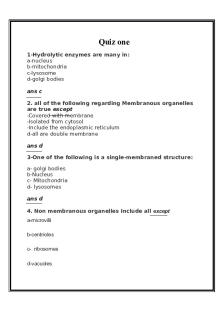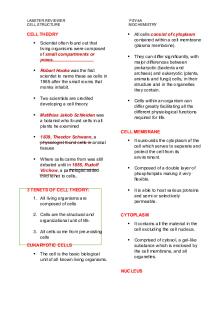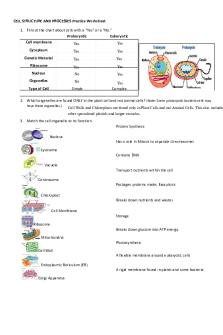Cell Structure Cell theory and internal organelles PDF

| Title | Cell Structure Cell theory and internal organelles |
|---|---|
| Author | may kasumi |
| Course | Microbiology and Parasitology |
| Institution | Benguet State University |
| Pages | 8 |
| File Size | 410.9 KB |
| File Type | |
| Total Downloads | 169 |
| Total Views | 706 |
Summary
Virtual Lab ReportCell Structure: Cell theory and internalorganellesThis lab report is for you to reflect on what you completed and learned in thissimulation, and to practice your written scientific communication skills.1. Describe the overall objective and make a hypothesis.What is the overall purp...
Description
Virtual Lab Report Cell Structure: Cell theory and internal organelles
This lab report is for you to reflect on what you completed and learned in this simulation, and to practice your written scientific communication skills.
1. Describe the overall objective and make a hypothesis. What is the overall purpose of the experiments or activities? Make a hypothesis if applicable. Hint: The purpose is often stated in the welcome message of the simulation.
The objective of the simulation is to learn about cell theory and what makes different types of cells unique. These concepts will help us solve a problem. Somewhere some hikers recently discovered a dead pair on their trail. With these concepts we will be able to analyze the organisms in the surrounding environment to determine whether the bear died from being poisoned or from other underlying causes. Hypothesis: The bear died from being poisoned. The bear died from other underlying causes.
1
Copyright Labster ApS 2021 All Rights Reserved
2
Copyright Labster ApS 2021 All Rights Reserved
2. Summarize the steps taken in the simulation. Explain each step you completed including the equipment and techniques you used. Hint: You can use the “MISSION” tab in the LabPad as inspiration. Materials: +Sample from the bear’s mouth (something kind of gross) +Holo-floor +Floating screen +Cell Theory: 1. All living organisms are composed of cells. 2. Cells are the structural and organizational unit of life. 3. All cells come from pre-existing cells. +4 types of animal cells
Procedure: a. Determining whether the dead bear died from poison or other underlying causes. 1. Take a sample from the deceased bear’s mouth. 2. Analyze the unknown sample in microscopic view on the holo-floor. -Microscopic view; there are lines separating the samples into many smaller compartments. These are called compartment cells by Robert Hooke (1665). 3. Looking at the different microscopic cell structures of organisms in the area. -Organisms; mint root tip, rabbit, deer 4. Answering question Part 1: Finding cells when examining various types of tissues under the microscope helps scientists agree on the first principle of the cell theory. Of the following is the first principle of cell theory? Answer: All organisms are made up of cells. 5. Answering question Part 2: You can observe the first principle recorded for you on the floating screen. The two scientists credited for developing cell theory extrapolated this first concept to all of life. What was the second principle of cell theory that they postulated? Answer: Cells are the structural and organizational unit of life. 6. Clicking on organisms to identify whether they are multicellular or unicellular. 7. Answering question Part 3: All eukaryotic organisms pictured here are multicellular while the prokaryotic Organism is unicellular. All eukaryotes-no matter their shape or size- have one organelle in common.
3
Copyright Labster ApS 2021 All Rights Reserved
The presence of this organelle is also the main difference between eukaryotes and prokaryotes. Do you know which organelle I’m talking about? Answer: Nucleus With this information it allows us to analyze the unknown sample from the bear’s mouth to determine if the cells have a nucleus and whether that makes them eukaryotic or prokaryotic. 8. Learning about the third principle of the cell theory: Click on the mint root tip, from the holo-floor click on the area where new cells come from. 9. Finding the unicellular organism in the forest which is the cyanobacteria. 10. Determining from the shape of cyanobacteria whether they have both a cell wall and a plasma membrane or only a plasma membrane. 11. Filling up the cell division table: A. The floating screen has a table of cell wall and no cell wall. B. Click on the different organisms in the forest. C. Group them whether they have cell wall or plasma membrane. 12. Answering question Part 4: It rained in the forest, living organisms ran for cover. It seems that the storm has made the organisms with cell membranes disappear, while the organisms with cell walls remain. Why might this be? Answer: Cell walls protect organisms from harsh environmental conditions. 13. Figuring out what multicellular organism in the forest that has a cell wall but is not a plant which is the mushroom. 14. a. Look through the unknown sample from the bear’s mouth again. b. Identify if it has a cell wall or not. *The sample was identified as to not have a cell wall. Thus, concluding the bear to have eaten something that has nuclei or cell membrane. This would mean it ate some sort of animal before it died. 15. To determine which type of animal it ate, build the 4 basic types of animal cells to re-create the entire animal and discover its identity. a. Click on the shape of the osteocyte which is a star shape. b. Place the proper internal organelles in the cell’s cytoplasm, the membranous endoplasmic reticulum, the nuclear envelope, the Golgi apparatus, mitochondria, ribosomes, and lysosomes. c. Add the appropriate cell structure: the extracellular matrix and the cellular processes. 16. Answering question Part 5: What is the main purpose of the extracellular matrix surrounding osteocytes? Answer: Bone strength 17. Look at the floating screen to see the skeleton of the animal the bear ate before it
4
Copyright Labster ApS 2021 All Rights Reserved
died. A. Build the next cell type. B. Examine the nervous tissue on the floating screen. The neuron cell bodies are darker than the rest of the tissue. C. Click view image to see the image on the floating screen D. Click on the shape of this cell depicts, it is a rectangular shape. 18. Answering question Part 6: Rather than placing all the internal organelles again, choose which of the following combinations include only organelles present in ALL animal cells? Answer: Nucleus, Golgi apparatus, and lysosomes 19. a. Add the appropriate cellular structure to complete the neuron, which is the Axon and dendrites b. Look at the floating screen. From the nervous system on the floating screen, we can get an idea of what type of animal the bear ate before it died. c. Muscle tissue is composed of muscle cells, or myocytes. Look at all those dark elongated nuclei. This might help guess a common shape of myocytes. d. Click on the shape that depicts what shape of a myocytes and it’s a rectangle. 20. Answering question Part 7: Muscles contain long fibers, making the general myocyte cell shape elongated. Which of the following internal cellular structures is unique to myocytes? Answer: Sarcomeres 21. A. Add the appropriate cell structure to complete the myocyte, which is the sarcomere 22. The last type of cell to build to discover the identity of the eaten animal is an epithelial cell. a. Click view image. b. View image and choose which shape represents the epithelial cells seen in the tissue and that is the round shape. c. Add the right cellular structure to complete the epithelial cell which is the tight junction and extracellular matrix. 23. Building all 4 basic cell types, we can see that the bear ate a fox before it died. This means the bear probably died of old age or other underlying causes, rather than being poisoned.
5
Copyright Labster ApS 2021 All Rights Reserved
3. Discuss the conclusions and implications. How do your results relate back to the original purpose and your hypothesis? Were there any systematic sources of error that could have affected the results? What did you learn? What is the importance of these findings and how can you apply them to other real world situations?
6
Copyright Labster ApS 2021 All Rights Reserved
7
Copyright Labster ApS 2021 All Rights Reserved
Documentation Attach photodocumentation/ screenshot of the your group taking the labster simulation and the score of the group.
8
Copyright Labster ApS 2021 All Rights Reserved...
Similar Free PDFs

Cell Biology Quiz CELL ORGANELLES
- 10 Pages

WS-Cell Organelles+ - Lab
- 5 Pages

Cell Organelles Review
- 5 Pages

Cell Structure and Magnification PPQ
- 28 Pages

Cell Structure SE 1
- 3 Pages

Labster 1 cell structure
- 10 Pages

Cell Structure (reviewer)
- 7 Pages

Structure of generalized cell
- 2 Pages

Cell Structure Worksheet
- 1 Pages

Cell Structure notes
- 13 Pages

Cell Structure Practice
- 3 Pages
Popular Institutions
- Tinajero National High School - Annex
- Politeknik Caltex Riau
- Yokohama City University
- SGT University
- University of Al-Qadisiyah
- Divine Word College of Vigan
- Techniek College Rotterdam
- Universidade de Santiago
- Universiti Teknologi MARA Cawangan Johor Kampus Pasir Gudang
- Poltekkes Kemenkes Yogyakarta
- Baguio City National High School
- Colegio san marcos
- preparatoria uno
- Centro de Bachillerato Tecnológico Industrial y de Servicios No. 107
- Dalian Maritime University
- Quang Trung Secondary School
- Colegio Tecnológico en Informática
- Corporación Regional de Educación Superior
- Grupo CEDVA
- Dar Al Uloom University
- Centro de Estudios Preuniversitarios de la Universidad Nacional de Ingeniería
- 上智大学
- Aakash International School, Nuna Majara
- San Felipe Neri Catholic School
- Kang Chiao International School - New Taipei City
- Misamis Occidental National High School
- Institución Educativa Escuela Normal Juan Ladrilleros
- Kolehiyo ng Pantukan
- Batanes State College
- Instituto Continental
- Sekolah Menengah Kejuruan Kesehatan Kaltara (Tarakan)
- Colegio de La Inmaculada Concepcion - Cebu




